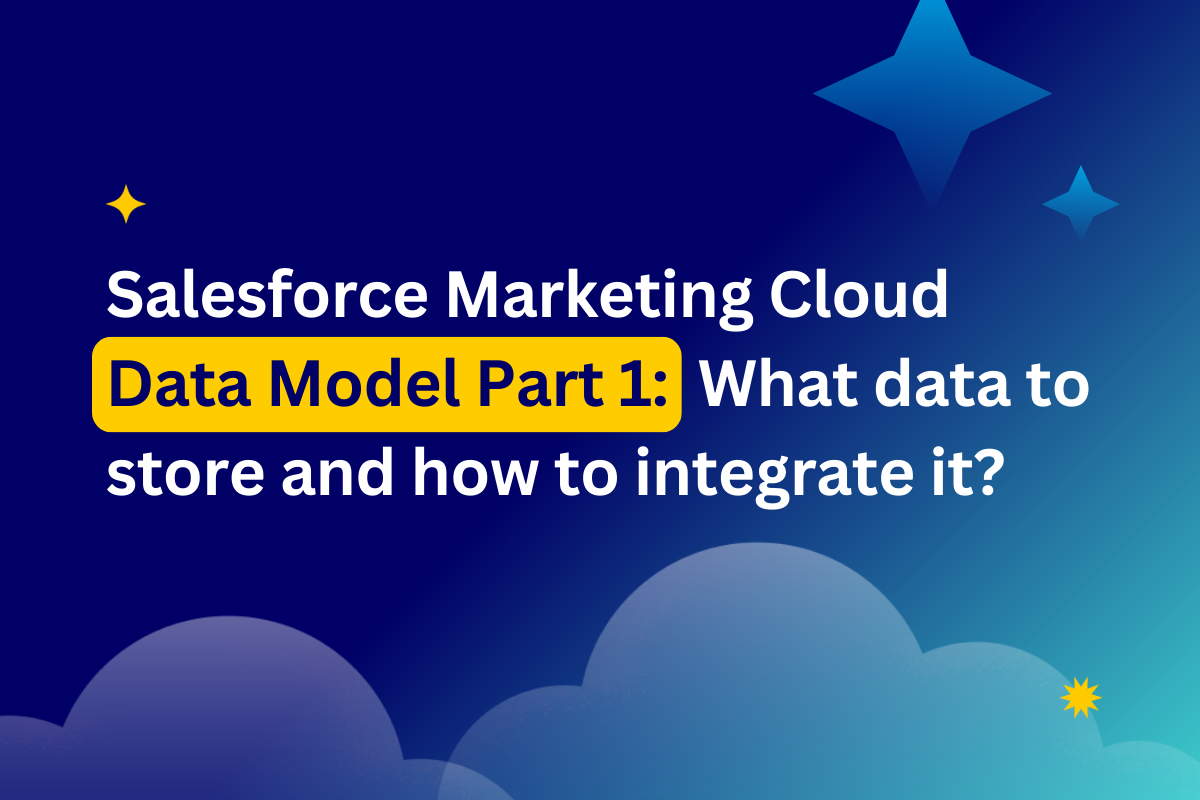
Have you ever wondered about the different ways you can manage your data in Salesforce Marketing Cloud (SFMC)? In this series of articles, we will shed some light on the out-of-the-box Salesforce Marketing Cloud data model, cover what tools are available in SFMC and point out best practices along the way. It all starts with asking yourself what data sources you want to use in SFMC.
What source data do you want to use in Salesforce Marketing Cloud?
As we will see, Salesforce Marketing Cloud (SFMC) provides us a great deal of flexibility with regards to our data model. As a consequence, SFMC can support nearly as many use cases and journeys as you can think of, provided you have the data to support them.
For starters, it can make great sense to collect subscribers, leads, and other information customers may leave behind in forms and store them in SFMC. This way this information can be used for campaigns or even trigger the start of a journey in real-time, such as a welcome email or confirmation email.
Many SFMC customers choose to connect their CRM (Customer Relationship Management) to the platform. This allows them to not only push relevant contact information to SFMC, but also commercial information, such as orders (usually B2C) or opportunities (usually B2B). Doing so allows for myriad automated journeys, and can provide marketers with the right information to execute cross-sell or upsell campaigns.
Depending on your industry, you may be able to obtain interesting commercial data from other systems as well. For instance, think of POS (point-of-sale) systems common in retail which can be used during the customer checkout at the registry. The digital equivalent of those are of course eCommerce platforms, of which we have seen a great rise not just in B2C, but also in B2B. Other customers may keep track of things like orders in ERP (enterprise resource planning) software. This too can provide interesting data to be leveraged in (or at least trigger) a journey inside SFMC.
In the examples above, we were still discussing using that data for commercial purposes. But as you may have realized, you may as well use SFMC for transactional communication. The platform even allows you to set up different send classifications that come with their own unsubscribe mechanisms. Indeed, there are communications from which a customer should not even be able to unsubscribe. Think of communications you may have a legal obligation to send out, such as invoices or updates in your terms & conditions.
Some customers seek to connect their social media to SFMC in different ways. A common use case is connecting the out-of-the-box Facebook lead capture feature that the Salesforce Marketing Cloud Advertising Studio supports. Of course, more extensive possibilities exist with Social Studio for SFMC.
If you are looking into triggering different kinds of time-sensitive and real-time communication, you may want to consider logging certain “events” inside SFMC. Think of events such as webpage visits, physical store visits (using technology such as beacons or geofencing), or user actions taken inside one of your mobile apps. Besides leveraging such data as triggers for real-time communication (mobile push message, an SMS,…) just having the data in SFMC may open up interesting scenarios for targeted outbound campaigns. Just be mindful of the amount of data you may need to store.
There may be heaps of other data you may want to use (event attendees, brokered data, legacy data from your previous marketing automation platform,…) and there are probably as many cases as there are tools and systems out there. However, it is not important to have all your data in SFMC. What is important is that such data is useful and used. Neither is it important to have all your data in SFMC at once. Marketing automation platforms, like your organization, tend to evolve and hopefully grow. Take it one step at a time. After all, you will also need to consider how you will get your data inside of SFMC.
How will you integrate your data in Salesforce Marketing Cloud?
There are several ways you can integrate data inside Salesforce Marketing Cloud. Deciding which way to use will depend a lot on the data source and the purpose of that data. Remember that just because a certain way to integrate data is available, does not mean you have to use it. Always put the journeys you want to support first and then consider how to best support them.
The most basic way to integrate data is through manual imports. Throughout SFMC, there are places where you can upload files in different formats, such as CSV or Excel files. This process is relatively easy, quick and may be familiar to many marketers. It could be used when you first set up SFMC, have a one-off list (for example from an event) that you want to use, or when you don’t have an immediate alternative. However, imports have drawbacks, such as being laborious and increasing the risk of human error. It also leaves the door open for poor data quality or even mismanagement of customer consent – an important consideration in this post-GDPR era.
Many customers who have SFMC will also have some of Salesforce’s CRM solutions, such as Sales Cloud or Service Cloud. Sometimes, these solutions are collectively referred to as “Salesforce Core”. For simplicity’s sake, we will use the term SFDC (Salesforce.com) which has been around for longer. When this is the case, it usually makes a lot of sense to use ‘Marketing Cloud Connect’, the out-of-the-box connector that is available in Salesforce Marketing Cloud under the Contact Builder. We will revisit this subject in one of the next articles in more detail. In the meantime, just be aware that this connector is unidirectional (data will only sync from SFDC to SFMC, not vice versa) and a given record may take up to 10 minutes to sync (which may be a problem for journeys that need to be real-time).
If you are looking to integrate a system other than SFDC with SFMC and that integration does not have to be real-time, then using FTP (file transfer protocol) integration may be a good option. SFMC allows you to set up FTP server locations on which files can be placed (manually or automatically). SFMC can then fetch these files and import the data they contain into the platform. For this, you will need to create automations in the SFMC Automation Studio that fetch and import the data at a regular time – something commonly referred to as a “batch process”. By the way, the same process in reverse can allow you to export data to other systems as well.
FTP integration can support many use cases, but if you are looking for something that can let data sync in real-time and be more secure, you may want to go with API integration. A word of caution: This will effectively require you to write and manage your own code to integrate SFMC to your other internal applications. Sometimes this may be limited if it is only to support a specific journey or use case. But if you intend to make this integration robust and scalable, you may even need to allocate several full-time resources to this. Having said that, API integration is the way to go for real-time communication and leveraging capabilities like triggered send to the fullest.
A technical side note to the API integration: A significant portion of the SFMC API is not based on REST API (the more common industry standard these days) but also SOAP API (which resembles XML to some extent). In particular, the SFMC API to manage data is SOAP-based, so there is no real way around this. As a developer, you will first want to create a standardized set of methods to interact with SFMC. This is essentially what we did at DESelect to create the plug-and-play kind of app that it is. By taking care of a robust API ourselves, we allow customers to leverage all their data immediately and in real-time inside of our app.
Lastly, there are some ways to integrate data inside of SFMC that could be categorized as “other”, because they serve to connect very specific apps or modules within the platform. Think for instance of the Facebook lead capture feature, which we mentioned earlier in this article.
Conclusion: What data to store in Salesforce Marketing Cloud and how to use it?
With Salesforce Marketing Cloud (SFMC), you have a powerful platform in which you can store many data sources and integrate these in several ways. Throughout this article we emphasized the importance of asking yourself first: What journeys do you want to support with SFMC? What campaigns will you do using SFMC? How will you use your data in SFMC? Only when such questions have an initial answer, you will have a framework to help you decide what data sources to integrate into SFMC. Once things have taken off, you will want to review and revise that framework from time to time. Consider then if there are new journeys you want to implement, or perhaps more personalized versions of existing journeys can be designed. When that happens you can come back here for guidance.
Continue reading Salesforce Marketing Cloud Data Model Part 2: How to manage data in Email Studio.
- What source data do you want to use in Salesforce Marketing Cloud?
- How will you integrate your data in Salesforce Marketing Cloud?
- Conclusion: What data to store in Salesforce Marketing Cloud and how to use it?
Latest Articles
-
Kyra Constam, Creative & Web Manager
Company Culture Meet Our Team: Creative & Web Manager, Kyra Constam In the dynamic world of design, Kyra Constam stands as a definition of talent and innovation. Get her take on her DESelect journey → Her journey at DESelect began with the title of Senior Graphic Designer, where her talent and hard work shined […]March 27, 2024Salesforce Announce Marketing Cloud Growth Edition Built on Top of Data Cloud
While Salesforce’s Marketing Cloud has long been synonymous with cutting-edge marketing automation, the unveiling of Marketing Cloud Growth Edition (MCG) marks a pivotal moment in democratizing marketing prowess. It is the very first glance of a marketing app developed in-line with Salesforce’s core platform and what it embodies. It is a big announcement from Salesforce […]March 26, 2024What Are the Typical Stages of the B2C Customer Journey?
In the dynamic and competitive realm of B2C marketing, understanding the stages of the customer journey is essential for crafting compelling marketing strategies that resonate with consumers at every touchpoint. This journey, a detailed map of a consumer’s engagement with a brand, is pivotal in shaping customer experiences and driving conversions. Let’s embark on a […]March 21, 2024Segmentation in Salesforce Marketing Cloud (SFMC)
You’ve already mastered segmentation in your everyday life. Your relationship with your family, friends, and colleagues is the biggest proof of your mastery. Why? Because you know what everyone around you likes and dislikes. And you tailor to their segment their behaviors, needs, lifestyles, and hobbies to keep them happy. If your best friend is […]March 20, 2024Join our newsletter to receive updates and helpful SFMC guides.


















